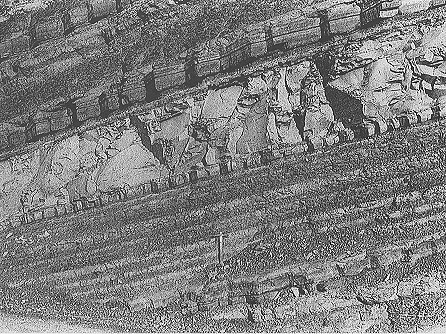
Meso-scale view of parallel bedding: turbidites and saw-tooth
profile
Plate 7

Meso-scale view of parallel bedding: turbidites and saw-tooth
profile
Plate 7
There are many roads crossing the Apennines, and the turbidite layers of Marnoso-arenacea Formation can be approached along them for a closer examination. You see here an example, with the typical saw-tooth profile of sandstone beds, induced by fracturing and weathering of the rock. Two fracture systems, both perpendicular to bedding, isolate blocks of sandstone that periodically fall from cliffs and roadcuts. In this section, sandstone beds are relatively rare and separated by thick mudstone intervals. The mudstone, anyway, is not monogenic: three different types are present in this outcrop: a light, calcareous mudstone (a marl) forms a prominent bed in the central part; above and below it, alternating bands of different gray tone occur. They are a few centimeters thick and have a variable carbonate content (higher in lighter beds). A thin sole of cemented carbonate sand (calcarenite) supports the lighter marl bed.
On the whole, five lithotypes (sandstone, calcarenite, 3 types of mudstone) appear here. Let us see whether they form a random succession of beds or are associated into layers. Sandstones form couplets with darker mudstones (upper left- and lower right-hand sides), so defining turbidite layers. The calcarenite forms a similar couplet with the light marlstone: this is also a turbidite but of different composition (carbonate clastic) and provenance: the carbonate derives from the accumulation of small skeletons of organisms, whereas the predominant turbidite layers were fed from a siliciclastic, terrigenous source. Siliciclastic means a detritus composed of quartz and other minerals rich in silica, i.e., silicates; terrigenous means coming from land, or terra firma.
We thus have a calcareous turbidite interbedded with terrigenous turbidites. But the story does not end here. Dark mudstones, decoupled from sandstone beds, alternate with lighter ones; they represent the deposit of slow, dilute turbidity currents that carried no sand in suspension or had lost it in a previous tract of their path, closer to the source (see sketch attached to plate 69). The lighter mudstones are richer in carbonate remains of plankton falling from superficial waters; they mixed with terrigenous mud forming a hemipelagic deposit, i.e., the normal sedimentation of the periods when turbidity currents were inactive. These hemipelagic muds had a much slower sedimentation rate than turbiditic muds; for this reason the skeletal remains, representing the biological productivity of the ocean, reached a higher concentration there. As turbidites are practically instantaneous events, the actual geologic time is recorded by hemipelagites; the distinction between the two types of mudstone is thus relevant for dating the whole formation or parts of it: samples must not be taken from turbidite mudstones, also because they are almost barren, i.e., devoid of fossils.
In conclusion, two types (and ranks) of couplets can be defined here: one is formed by the two members of a turbidite event (sand - mud), the other by the alternation of a turbiditic layer and a hemipelagic bed. In this second case, the sand bed of the turbidite can be missing, leaving a muddy turbidite.
Marnoso-arenacea Formation, northern Apennines.